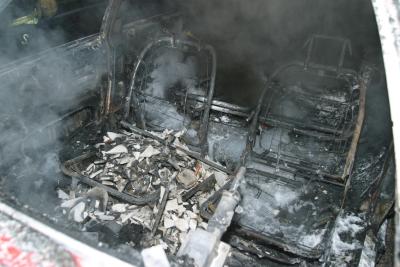
The element of fire inhabits our daily lives, mostly in a contained and useful way. We use it to cook, heat liquids and run our internal combustion engines. We can cause it to happen, adjust and moderate it. Fire becomes a problem when its ignition sequence happens outside of our control, which usually ends in damage to and destruction of commercial or private property, and sometimes death. Fires are classified according to the materials involved in the combustion process. No two fires propagate and burn the same way.
Class A fires commonly result from ordinary combustible materials, including paper, wood, cardboard and some plastic materials. They appear frequently in household fires, from accidental ignition, lit cigarettes or spontaneous combustion. They require Class A extinguishers to put them out, since these extinguishers hold a great deal of water in the mixture.
Flammable liquids, such as gasoline, grease, cooking oil, acetone and paint thinner, define class B fires. These fires can originate in households, warehouses, shops and commercial properties, where such flammable liquids are used for household activities or in the manufacturing process. Class B extinguishers have square-foot ratings, indicating how much surface area can be contained with their use.
Class C fires involve electrical components and equipment, including circuit breakers and panels, wall outlets, appliance wiring, machinery and engine wiring. Common sources include automobiles, household wiring, generators, turbines, fans, refrigerators, toasters, ovens and stoves. Class C fires require chemical extinguishers, which are non-conductive, since water heightens the risk of electrical shock and further damage.
Fires rated as class D, typically found in foundries and chemical laboratories, involve combustible metals that have a high content of sodium, titanium, potassium and magnesium. Such metals burn by a spontaneous, chemical reaction, and can be quite dangerous in factories and plants where they have been stored. Specialized extinguishers must be used to combat metal fires.
Crown fires consume the very tops of trees in a forest setting, which causes the death of most trees. The flames spread from the uppermost treetop branches to the nearby branches of other trees. Some trees across the West, such as the lodgepole pine, have developed survival strategies in that they drop seeds when their cones open during a fire, resulting in new growth.
Surface forest fires burn trees from the forest floor up to approximately 10 feet above the ground. These fires burn the lower portions of the trunks of certain tall trees, such as sequoias, Douglas fir and ponderosa pine. The trees survive because of their thick and heavy bark, and their branches sit so high up in the crown that they cannot be reached by the flames. Surface fires can move very fast across the forest floor.
Forest ground fires burn the most intensely of all fires. They consume dried or decomposing wood, bacteria and fungi, large amounts of kindling, and trees of every type and species. Ground fires frequently rage uncontrolled and cover hundreds or thousands of acres. They can continue to burn under a snow pack during winter months, allowing them to reignite again in the Springtime. Ground fires rob the soil of important nutrients used for forest growth and reproduction. Alaska and British Columbia commonly suffer ground fires because of their higher elevation.
Oil fires involve oil derricks and offshore drilling platforms. When crude oil reaches its ignition temperature, it alights and spreads, as long as it contains oil molecules next to it. Oil typically burns on the surface of water, covering large areas, and can be corralled and contained only by foam and chemical expulsion from fire-fighting watercraft, or air-drops from specialized aircraft. Oil fires can spread by combining with natural gas and other flammable materials.